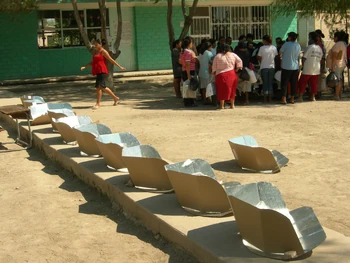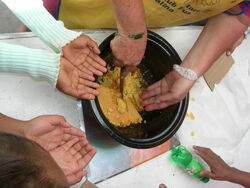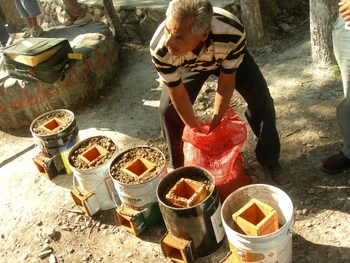Tom Sponheim (talk | contribs) (Adding categories) |
Tom Sponheim (talk | contribs) |
||
| Line 33: | Line 33: | ||
| + | {{clr}} |
||
==See also== |
==See also== |
||
*[[Media:Rotary_Volunteer_Service_Grant_61804_2007.pdf|Rotary Clubs of Fresno and Torreon Centenario Volunteer Service Grant document]] |
*[[Media:Rotary_Volunteer_Service_Grant_61804_2007.pdf|Rotary Clubs of Fresno and Torreon Centenario Volunteer Service Grant document]] |
||
Revision as of 20:00, 22 February 2010

Solar cooking class sponsored by Torreon Rotary Club in Torreon, Mexico by Wilfred Pimentel
Club Rotario Torreón Centenario has been promoting the use of solar cooking since 2006. The group sells solar cookers for 80-90 pesos, but when they are delivered to the communities, especially those in remote and rural areas, symbolic gifts are often accepted as payment. Dr. Irma Martinez, vice president of Club Rotario Torreón Centenario, says that each cooker has a lifespan of 4 years even though they are constructed out of cardboard. She also says that the only maintenance required of the solar cookers is to keep them clean of dirt.
Without spending a penny on the purchase of gas, the housewives of the Comarca Lagunera may prepare their food daily with the help of sunlight. The food made in solar stoves will not only be cheaper but more nutritious by reducing the quantities of oil and water in their preparation.
Dr. Irma Martinez, vice president of the Rotary Club Centennial Tower, reported that since 2006 the club has been promoting the use of solar stoves, which work with a simple technology to prepare daily soup, tamales, meat, beans, cakes and a variety of foods without using fossil fuels, only solar energy.

solar-cooked corn bread
In a visit made to her house, we see that the solar stoves are made by hand. The solar cooking technology was introduced two years ago by the Rotary Club of Fresno California, responsible for promoting the technology throughout the Americas.

sun cooking makes dessert
With a commercial price of 80 to 90 pesos, solar cooking not only offers the benefit of avoiding use of fossil fuels, but also that of saving water. Similarly it is not necessary to add cooking oil, the food cooks in its own juice. When cooking vegetables or meats there is no need to add water.
The black cooking pot is placed inside a polypropylene bag. One puts 2-3 small sticks or smooth stones underneath the pot, in order to promotes heat circulation through the bottom of the pot. The polypropylene is closed with a string.
Place the solar stove in the direction of the sun and when standing behind it, make sure your shadow falls behind the CooKit (solar stove). Re-orient the CooKit towards the sun after 1-2 hours.
The preparation of food varies not, in other words you can use your own recipe for making rice or a cake, but remember that the amount of water is slightly less than cooking on the stove top.
After an hour and a half, food will be done. Remember to use pot holders when removing the black pot from the polypropylene plastic bag to avoid burning yourself.
Training
Solar cookers training is done by a team of three, each person received training to manufacture them. The sales price is 80 to 90 pesos. In some remote communities, some small symbolic contribution is asked for.
So far 4,200 solar cookers have been built. Irma said they have done a promotion in many other communities besides La Laguna, such as in the states of Chiapas and Hidalgo, some have been sent to countries such as Haiti. The introduction of CooKits have brought good results.
Some training also covers the construction and use of rocket stoves, which are fuel-efficient wood-burning stoves.

1. constructing a rocket stove

2. adding pumice insulation
See also
- Rotary Clubs of Fresno and Torreon Centenario Volunteer Service Grant document
- Wilfred Pimentel
- Rotary Club of Fresno
External links
- Cocina solar, una opción económica - El Siglo de Torreón
Contact
Dr. Irma Martinez Vacio
Tel: +52-871-720-4547
Dr. Lucero Mendez
Tel: +52-871-267-9096
